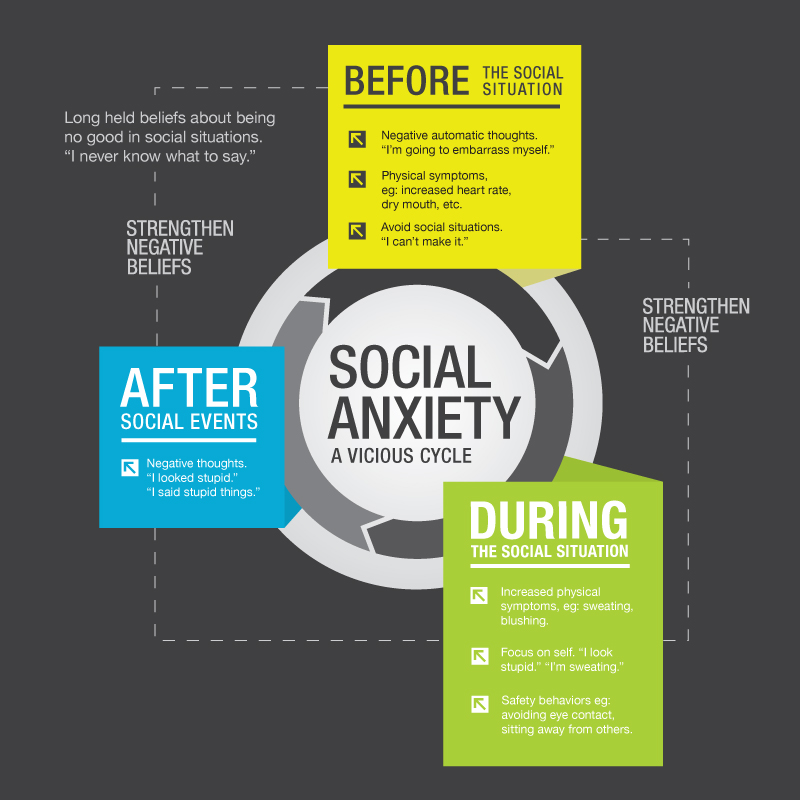- A Quick Guide
- What is social phobia?
- What keeps the cycle of social phobia going?
- 1. Negative beliefs
- 2. Negative assumptions
- 3. Rigid rules of life
- 4. Social situations trigger the anxiety response: seeing self from a third-person perspective
- 5. Activation of ‘negative thoughts, emotions, and physical sensations’ cycle
- 6. Developing ineffective avoidance or safety behaviors
- 7. How the cycle of social phobia continues
A Quick Guide
Social phobia, or social anxiety, is an intense fear of being judged or embarrassed in social situations. Negative beliefs, assumptions, and rigid rules contribute to the cycle of anxiety, triggering negative thoughts, emotions, and physical sensations. Ineffective avoidance behaviors perpetuate the cycle, reinforcing negative self-beliefs and maintaining the phobia.
What is social phobia?
Social phobia, also known as social anxiety, refers to the intense fear of being evaluated or scrutinized in social situations. The person worries about embarrassing himself, especially while doing activities in which others can observe him. Such an individual is also afraid of exhibiting anxiety symptoms in public. For instance, they may find physical reactions of sweating and blushing humiliating. Similarly, they are also afraid of fumbling over words, talking in an odd manner and conscious about sounding stupid or people finding them boring.
Watch: [Phobias – specific phobias, agoraphobia, & social phobia]
Social phobia has a negative influence on their relationships, performance in school or at work, and overall daily functioning. Any person would want such symptoms to stop. Likewise, people with social phobia make efforts to do so but they are usually ineffective.
Then, the question is,
What keeps the cycle of social phobia going?

1. Negative beliefs
According to Clark and Well (1950), people with social phobia have certain negative beliefs about themselves that are rigid and resistant to change. For example, they may believe ‘I am abnormal’, ‘I am strange’, ‘I am stupid’, ‘I am a failure’, ‘I am incompetent’. Etc.
2. Negative assumptions
Based on these beliefs, they form assumptions that are either untrue or exaggerate negative consequences. For example, ‘If I fumble while speaking, others will think I am incompetent, ‘If I make a mistake, people will think badly of me’, ‘If I do not get high grades, everyone will think I am a failure’. Etc.
3. Rigid rules of life
Based on the negative assumptions, they form rigid rules of life to prevent them from coming true. For example, ‘I must always be calm while speaking’, ‘I should always sound intelligent’, ‘I should never let others see my anxiety’. Etc
4. Social situations trigger the anxiety response: seeing self from a third-person perspective
Yet, in social situations, when things do not go in accordance with their rigid rules, it activates an anxiety response in them. They become hypervigilant of themselves and of what is going on in their mind and body. They even start to look at themselves from a third-person perspective i.e. how others may be perceiving them at that moment.
While doing this, they see themselves as their worst fear. For instance, they will perceive others to be thinking they are a failure, incompetent, stupid, odd, peculiar looking, etc. While all of this is an exaggeration and not true. Yet at that moment, they believe this portrayal to be true.
5. Activation of ‘negative thoughts, emotions, and physical sensations’ cycle
Such high self-consciousness activates a ‘negative thoughts, emotions, and physical sensations’ cycle in them. This starts at any point and continues to intensify the anxiety response.
For example,
‘I sound stupid’ (thought) leads to feelings of anxiety (emotion). This leads to increased heartbeat, increased breathing, and flushing of the face (physical sensations). Following this, the person fumbles on his words and thinks ‘This proves it. Others must be thinking I am stupid’ (thought), feels more anxious, the physical sensations intensify, and so on.
6. Developing ineffective avoidance or safety behaviors
To avoid this from happening in the future, such an individual develops coping/avoidance or safety strategies. These strategies are usually ineffective since they intensify or prolong the symptoms and increase a person’s vigilance of themselves. They also make a person seem distracted or withdrawn which makes people think they are reserved or not interested. So, even if they planned to give positive feedback, this reduces its chances. In turn, this strengthens the person’s negative self-belief.
7. How the cycle of social phobia continues
Finally, the person believes the safety behaviors avert chances of failure in social performance, unaware that they instigate it. This keeps the cycle of negative beliefs, thoughts, emotions, and physical sensations in a loop.
For example,
A person with a phobia of speaking in public develops a coping strategy to over-rehearse and over-prepare his speech to ensure he does not fail. He may over-plan what he will say, how he will say it and tries to speak clearly without pausing. This only makes him more vigilant of his internal state and increases the chances of the cycle of ‘negative thoughts, emotions and physical sensations’ being triggered. Thus, a small mistake or deviation from his planned speech activates the anxiety response on the day of the big speech. In other words, the ineffective strategies kept the cycle of social phobia in a loop.
We hope you found the above explanation of the underlying process of social phobia, useful. If you want to know more about What is social phobia or social anxiety & How to identify it? read about it on our website.


